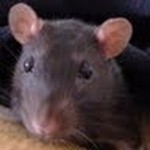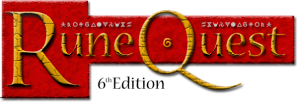The post below is written by UbiquitousRat, a guest blogger for The Iron Tavern.
Following the near-collapse of my home roleplaying group, saved only by the decision to drop our most recent campaign, I’ve begun to tinker with two convergent ideas:
- Trying to build a solo-game using Mythic Roleplaying
- Testing out two promising candidates for fantasy RPG systems in my home-brew setting.
This morning, in a bid to get things rolling and take advantage of a day off work, I decided to try out character creation using RuneQuest Sixth Edition. This article is a review of those efforts and my thoughts on the experience.
RuneQuest
A long time ago, in a city far far away, a young boy and his father bought a boxed game called “RuneQuest”. This was the first RPG we had bought and, frankly, Dad wasn’t impressed once he opened it and found out what it was. For my part, however, I was hooked.
I remember rolling up my first character and reading through the rules with avid pleasure. We had some resources from Glorantha too, such as Apple Lane, and I still recall being slightly amused by the idea of sentient Ducks.
RuneQuest, however, won a space in my heart. I only played it a couple of times with friends, who much preferred to play D&D and Traveller, but I was a convert to the style. It was a game for heroes – proper heroes – and not just a game. And RuneQuest gave birth to my first campaign world: Mykovnia.
Return to Mykovnia
Some years ago I had a recurrent dream. It was a dream of the same world that I used to dream about when I was a teenager: Mykovnia. I shared the dream with a friend (now since lost to the aether) and used the dream to write some very short pieces of fiction.
Wanting to return to Mykovnia as a gamer I ran a very poor, over-rushed game using the Rolemaster FRP games system. I realised that, for my home group, the world was forever tainted as a failed game. Yet… for me, the world lives on. I learned today that I should have used RuneQuest.
Today, then, as I sat down to begin a solo-game using Mythic it occurred to me to also pick up the book that has been gathering dust for too many months: RuneQuest Sixth Edition.
RuneQuest 6e
This is a beautiful soft-backed book. I would pay serious cash for a hardcover.
The book covers all that is needed to play a fantasy RPG: Character Creation; Skills; Equipment; Game Mechanics; Combat; Magic (5 systems); Cults; Creatures; GMing. It is wonderfully written and presented, with some very nice black-and-white artwork throughout. At 450+ pages it’s a weighty tome.
I began to read the book months ago. The problem was that, although excellently written, it is done in a style which was designed to support a “read along as you play” approach. To be frank, I found this hard to get in to and realised that it’d be best to wait until I wanted to try it out. That day took far too long to come.
RuneQuest is a d100 game descended from the Basic Roleplaying system. It is skill-based and flexible, being written so that it can fit any setting of the GM’s design. Gone are the days of Glorantha, although the HeroQuest 2nd Edition supplements would be very easily adapted to the game. By the author’s own admission, “RuneQuest has always excelled at supporting Sword and Sorcery, Sword and Sandal, and mythic Ancient World sub-genres.” It’s this that makes it perfect for Mykovnia.
Character Design
Here’s where I picked up, working through the three-chapter process as written. RuneQuest emphasises background development and deeper roleplaying… so I started with an extract from my own writing:
“Out on the plains, away from the cover of the forest that would protect his tribe, the hunter was watching the lone wolf as it padded along the ancient trackway. Clutching his spear in his cold hands, chest and stomach pressed close to the snow-covered grass, he scented the air and squinted his eyes against the weak morning sunshine.”
This character is called Darryn. Later I described him as, “tall and powerfully built, with lithe form and pale skin.”
Characteristics
RuneQuest provides three systems for the core seven attributes, called Characteristics. I chose the third, a points-buy option, so that I could fully model the hero as I wanted. In truth, this was a quick process and the derived characteristics were really easy to calculate too.
What I really liked was that there is no obvious “dump stat” and that all the core Characteristics derive further stats that are essential. There are Hit Points but they are spread over seven hit locations, instead of being a simple total.
Adding Luck Points and Action Points to my sheet promised systems for creating the kinds of cool deeds Darryn might get up to in the future. I buffed up his Size and Constitution, gave a reasonable Strength and Dexterity, dropped below average with Charisma, and left Intelligence and Power roughly average.
The last step was to add two Characteristics together for each of a range of Standard Skills (which any character can use), giving Darryn some basic percentages from which to develop.
Culture
Here is where I started to think, “This is cool!”
RuneQuest provides a choice of four major Cultures: Barbarian (which I chose), Civilised, Nomadic or Primitive.
These cultures each give you some focused training in a selection of Standard Skills; they also add a choice of three Professional Skills (which cannot be used untrained) based on the given culture.
I chose Navigation, Survival and Tracking. I also gained a Combat Style – a culture-specific but highly flexible concept for choosing how your hero fights and defends – which is called “Wolf Hunter”.
What I really like about Culture, however, is the gentle flexibility of the system. Gamemastery is promoted as the player and GM work out how their characters fit into a system of cultural ideas. It’s really very simple but also very powerful in yielding character detail.
The section winds up with generating some background details. A random roll gave Darryn a mark of the gods on his body, which I interpreted as a symbol on his left shoulder blade which was associated with the Moon Queen (his patron deity).
On top of that, rolling on a couple of extra tables, we discovered he has a father but no mother; two grandparents and a cousin rounded out his family. We also found out that he has a friendly contact in the form of the tribal Shaman. This gave me the idea for a second character who is the Shaman’s apprentice. All good stuff, eh?
Career
RuneQuest offers twenty-four classic Careers – which are professional training packages, really – and for Darryn I chose “Hunter”. This gives the hero some more training in appropriate Standard Skills and a chance to add three more Professional Skills and/or a Combat Style. I chose to simply replicate Darryn’s cultural training, boosting those core skills even higher.
Careers are impressive. There are enough basic choices to provide for most campaigns. If this isn’t enough there are rules for creating new ones. Once again, the GM is given the tools to fit things to their own world very effectively.
What I really liked, however, was the way in which the Culture and Career choices potentially meld to create a unique character. Choice is maximised and, given the array of options, I would expect to see some very different heroes created from even the same combinations. This is a powerful and yet simple system.
Finishing Up
Final steps included spreading around some bonus skill points, including being allowed to choose either another Combat Style or an additional Professional Skill as a hobby. I added Lore (Beastmen) to Darryn’s skills and smiled as I boosted up his core training.
Characters get some basic equipment based on their place in the social order of their culture. They also get some Silver Coins to buy stuff with. Darryn started with a shortspear, knife and some quilted leather armour. I bought him a short bow, Hoplite shield and various basic gubbins. This too was very simple to choose and record.
Filling out the Character Sheet, usually a chore, was facilitated by a very simple yet comprehensive design. I didn’t need the Magical sections… but these aren’t really a distraction either.
All in all, given a total of around two hours spent in design, reading the book from scratch, this was a pleasant and easy-to-follow system.
Verdict?
Honestly, I expected the game to feel very Old School. In reality, it doesn’t… even though it is a worthy successor to a very Old School system. I am impressed. I want to create another character.
What I like is the easy-to-follow steps. It’s a book written to be used, not read and shelved. In retrospect, I like this.
RuneQuest isn’t, however, a quick pick-up RPG system. This is a game for the serious roleplayer who wants to take the time to “get to know” their character. RuneQuest facilitates this style. It’d probably drive traditional D&D types nuts with the background details, however.
Overall, I want to dig deeper now. Next steps include wanting to create a magical character. From there I plan to run a test combat… and then dive into some play.
RuneQuest has me convinced. Hopefully this review will help you decide if it’s worth a look too.
Game on!
Bio
 UbiquitousRat is a long-time roleplayer and gamesmaster who has a history with gaming going back to 1979. In 1994 he joined Games Workshop, spending 12 years in the gaming industry at the coal-face of tabletop wargaming. In 1998 he founded the Friday Night Roleplay group at his home in suburban Nottinghamshire, UK, and ever since has been the primary GM. Oh, and he’s also a high school teacher during the daytime.
UbiquitousRat is a long-time roleplayer and gamesmaster who has a history with gaming going back to 1979. In 1994 he joined Games Workshop, spending 12 years in the gaming industry at the coal-face of tabletop wargaming. In 1998 he founded the Friday Night Roleplay group at his home in suburban Nottinghamshire, UK, and ever since has been the primary GM. Oh, and he’s also a high school teacher during the daytime.


Pingback: Casting Runes 3: Developing the Experience | Casting Shadows
Pingback: Saturday Seed ~ 152 (RuneQuest) | Casting Shadows